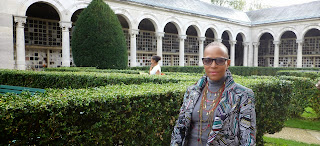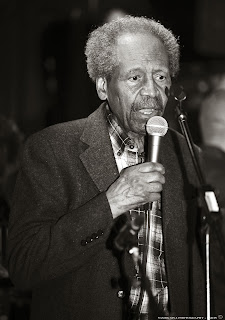On September 26, Doria Johnson and Nathalie Loison gave presentations on the topics of racial discrimination and lynching at Dorothy's Gallery.
Both women were moved by the experience. They share their reflections below.
Doria Johnson:
I was more than humbled by my experiences there in Paris. I was overwhelmed by the beauty of the cityscape, the architecture, the cobblestone streets, the parks, the river, and even the street-style clothing.
Doria on the Champs de Mars
Photo courtesy of Doria Johnson
Doria and Michael
Photo courtesy of Doria Johnson
Also, I could immediately identify with the urban experience of seeing many folks who looked like me in public spaces. I felt comfortable there, and kept thinking of the Black American intellectuals, artists, and even the proletariat, or working-class folks who preceded my visit, and understood why they felt compelled to stay, or "quit America" as many say.
More than anything, I was struck by the welcoming atmosphere that surrounded our visit. My partner, Michael, kept commenting on the kindness, genuine and warm personality of Nathalie Loison, who facilitated our visit. She was interested in making us feel comfortable, and was very concerned about our desires. She tempered that with pointing out what she loved about Paris. Of course, I had worked with her for a few years, so I sensed her spirit, but I did not expect to connect with her on so many levels. I confirmed what I suspected: women share experiences that transpire cultures and borders, and for those honest conversations I was most grateful. We shared how our mothers lived, and from that, we learned how to survive and live healthy lives.
The talk at Dorothy's Gallery exposed me to the public, albeit those mostly intellectually interested in my take on race in the U.S. The space was intimate, which allowed me the opportunity to visually take in people's responses--unlike an academic lecture hall. The questions that followed my talk were thought-provoking, and pushed back some of my theories such as the legal codification of the murder of Black boys and men based on racial profiling.
Doria addresses the crowd
Photo courtesy of Nathalie Loison
As an example, Romain Sinclair, an undergrad student studying in Paris and Northwestern University in Illinois, thought I went too far. He said he didn't believe that the U.S. actually sanctioned lynching, and this made me question the way I presented my case as well as my own socialization about America. As a result, I agreed to take a look at how I articulate with my analysis, and how I construct it for public consumption.
Speaking with the French press also provided me another avenue to disrupt the sometimes global miscalculated U.S. identity as post-racial--I have an opposite opinion of my home, especially with the confusing backdrop of the Obama presidency. These conversations force me to think more deeply about these issues, and these opportunities can only happen when a historian performs publicly. I treasure those moments, indeed, as I envision expanding my identity as a public historian.
Nathalie Loison:
We were first interviewed by two journalists. Doria started her talk showing and commenting on photos of lynched people. She told us a few facts about the history of lynching, then compared today's situation (Trayvon Martin's case) to the murders of Emmett Till and her great-great grandfather Anthony Crawford. She was asked several questions.
Talking about lynching
Photo courtesy of Nathalie Loison
There was a break, then I talked for half an hour about the way [Jennifer] Beals, [Tiger] Woods and [President] Obama's multiracial identities were depicted in the press (The New York Times, USA Today, US Weekly, The Huffington Post, People, the specialized press - Sports Illustrated, Ebony, Town and Country Mag, Curve Magazine, etc ... - the digital press, the local press - from Chicago, NY, Japan, Canada ..., InStyle, etc ...) from 1997 to 2009.
Nathalie Loison and Dorothy Polley
Photo courtesy of Nathalie Loison
1997 was the year when Woods declared he was multiracial; 2009 was the election of a biracial president; and from 2003 and 2009, Beals played the first openly biracial and gay female character. It appears that they were shown as models, heroes and icons that are perfect because they are mixed-race, but also as "the Other," marginalized and suspicious individuals difficult to categorize. Lastly, they were depicted as "deracialized" personalities (whose racial identity has been "erased" in a way).
Doria and I share a lot because as the daughter of a Cambodian mother (my father was French), I understand how difficult it is for immigrant women (or at least, my late mum) to feel integrated to a foreign society and culture. As a mixed-race person, I also feel close to the multiracial personalities (and anonymous citizens) I mentioned in my talk because I, too, have never fully felt part of a community or another.
************
If you like this posting, share it with your friends by using one of the social media links below!
Both women were moved by the experience. They share their reflections below.
Doria Johnson:
I was more than humbled by my experiences there in Paris. I was overwhelmed by the beauty of the cityscape, the architecture, the cobblestone streets, the parks, the river, and even the street-style clothing.
Photo courtesy of Doria Johnson
Photo courtesy of Doria Johnson
Also, I could immediately identify with the urban experience of seeing many folks who looked like me in public spaces. I felt comfortable there, and kept thinking of the Black American intellectuals, artists, and even the proletariat, or working-class folks who preceded my visit, and understood why they felt compelled to stay, or "quit America" as many say.
More than anything, I was struck by the welcoming atmosphere that surrounded our visit. My partner, Michael, kept commenting on the kindness, genuine and warm personality of Nathalie Loison, who facilitated our visit. She was interested in making us feel comfortable, and was very concerned about our desires. She tempered that with pointing out what she loved about Paris. Of course, I had worked with her for a few years, so I sensed her spirit, but I did not expect to connect with her on so many levels. I confirmed what I suspected: women share experiences that transpire cultures and borders, and for those honest conversations I was most grateful. We shared how our mothers lived, and from that, we learned how to survive and live healthy lives.
The talk at Dorothy's Gallery exposed me to the public, albeit those mostly intellectually interested in my take on race in the U.S. The space was intimate, which allowed me the opportunity to visually take in people's responses--unlike an academic lecture hall. The questions that followed my talk were thought-provoking, and pushed back some of my theories such as the legal codification of the murder of Black boys and men based on racial profiling.
Photo courtesy of Nathalie Loison
As an example, Romain Sinclair, an undergrad student studying in Paris and Northwestern University in Illinois, thought I went too far. He said he didn't believe that the U.S. actually sanctioned lynching, and this made me question the way I presented my case as well as my own socialization about America. As a result, I agreed to take a look at how I articulate with my analysis, and how I construct it for public consumption.
Speaking with the French press also provided me another avenue to disrupt the sometimes global miscalculated U.S. identity as post-racial--I have an opposite opinion of my home, especially with the confusing backdrop of the Obama presidency. These conversations force me to think more deeply about these issues, and these opportunities can only happen when a historian performs publicly. I treasure those moments, indeed, as I envision expanding my identity as a public historian.
Nathalie Loison:
We were first interviewed by two journalists. Doria started her talk showing and commenting on photos of lynched people. She told us a few facts about the history of lynching, then compared today's situation (Trayvon Martin's case) to the murders of Emmett Till and her great-great grandfather Anthony Crawford. She was asked several questions.
Photo courtesy of Nathalie Loison
There was a break, then I talked for half an hour about the way [Jennifer] Beals, [Tiger] Woods and [President] Obama's multiracial identities were depicted in the press (The New York Times, USA Today, US Weekly, The Huffington Post, People, the specialized press - Sports Illustrated, Ebony, Town and Country Mag, Curve Magazine, etc ... - the digital press, the local press - from Chicago, NY, Japan, Canada ..., InStyle, etc ...) from 1997 to 2009.
Photo courtesy of Nathalie Loison
1997 was the year when Woods declared he was multiracial; 2009 was the election of a biracial president; and from 2003 and 2009, Beals played the first openly biracial and gay female character. It appears that they were shown as models, heroes and icons that are perfect because they are mixed-race, but also as "the Other," marginalized and suspicious individuals difficult to categorize. Lastly, they were depicted as "deracialized" personalities (whose racial identity has been "erased" in a way).
Doria and I share a lot because as the daughter of a Cambodian mother (my father was French), I understand how difficult it is for immigrant women (or at least, my late mum) to feel integrated to a foreign society and culture. As a mixed-race person, I also feel close to the multiracial personalities (and anonymous citizens) I mentioned in my talk because I, too, have never fully felt part of a community or another.
Entrée to Black Paris!™ is a Discover Paris! blog.
If you like this posting, share it with your friends by using one of the social media links below!









































